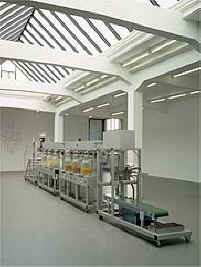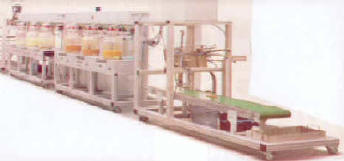|
IN
1909, Filippo Tommaso Marinetti, the poet and author of the "Futurist
Manifesto," proclaimed, "A racing car whose hood is adorned by
great pipes . . . is more beautiful than the Victory of Samothrace."
Within the next five years, artists as diverse as Fernand Lιger, Kasimir
Malevich, Francis Picabia and Marcel Duchamp all used mechanistic imagery
in their paintings to allude to the body the central icon of Western
art in motion or in repose. A more literal use of machine iconography
followed, in, for example, the work of Jean Tinguely, who produced
sculptures that could move, make noise, draw or self-destruct, like us.
"Cloaca"
(2000) represented a conclusion of sorts to a century of development in
machines that could duplicate human activities. This vast contraption
comprising an In-Sink-Erator, a computer-controlled reactor, peristaltic
pumps, an intricate electrical system and glass jars containing acids and
micro-organisms ingested and digested food with the sole purpose of
generating feces. It was a brainchild of Wim Delvoye, 36, the enfant
terrible of the Belgian art scene, and was realized with the help of
gastroenterologists, computer scientists and engineers in an extraordinary
feat of artistic collaboration.
What
humans produce effortlessly, "Cloaca" fabricated at considerable
cost, thus raising important questions having to do with consumer society
and the art market in particular. All art is useless, Mr. Delvoye claimed,
and this project underscored the futility of art and life.
Now
"Cloaca New and Improved" has arrived. This room-size
intestine, which was specifically adapted to fulfill sanitary requirements
of the United States Department of Health, will be featured at the New
Museum of Contemporary Art in SoHo starting on Friday and will be fed
twice a day, courtesy of several New York restaurants, through April 28.
Mr.
Delvoye, who lives in Ghent, was raised in Wervik, a small town in West
Flanders. His upbringing was nonreligious, he says, but growing up in a
Roman Catholic society, he was struck by the power of images.
"I
have vivid memories of crowds marching behind a single statue as well as
of people kneeling in front of painted and carved altarpieces," he
said in a recent conversation at the Chelsea Hotel in Manhattan.
"Although I was barely aware of the ideas lurking behind these types
of images, I soon understood that paintings and sculptures were of great
importance."
|
In
his childhood, Mr. Delvoye often attended exhibitions with his
parents, and he spent much of his leisure time drawing. But he
became disillusioned with art school. "There I was exposed to
the various reductivist paradigms of 20th-century art," he
said, "while I, on the other hand, sought to create an art that
appeals to the people." To achieve his goal, he turned to what
he knew best, the world of his youth, which was rich in the folklore
and kitsch condemned by the academy. |
 |
"We
were told in school that it was almost impossible to make a living
producing art," he said. "Moreover, it was understood that as
Belgians we could not possibly hope to become players on the international
scene. This freed me. I had nothing to lose."
Mr.
Delvoye began to paint thickly over wallpaper and carpets, following the
lines and color schemes of the ready-made patterns and thus rebelling
against the fashionable idea of free expression. "One century ago,
the poor lived in empty spaces while the rich covered their walls with
wallpaper and their floors with carpets, and hung chandeliers from their
ceilings," he said. "Today the situation is reversed, and the
rich choose to live in white, minimal spaces."
From
the start, his work had to do with class, decorum and conventions of
taste. But he decided to move away from anything smacking of
Neo-Expressionism. He was attracted to artists who were not "involved
with the pleasure of painting" but who illustrated an idea, he said.
"Artists like Magritte, who is such a dreadful painter. He is so
hygienic. Here is the concept he simply carries it out."
Unlike
Magritte, Mr. Delvoye eventually had others execute his works, guided by
his designs. He himself did most of the work of the late 1980's: the gas
canisters and saw blades painted with patterns appropriated from knockoff
delftware, and the ironing boards and shovels decorated with coats of
arms. After 1990, the production of his work was almost always entrusted
to specialists.
"These
historical images amaze me," he said of the coats of arms,
"because they survive through all these centuries and still exist as
a paradigm of something. The use of such explicitly regional imagery has
made my work internationally relevant in this era of identity politics.
"We
Belgians are attracted to humble things and are aware of the futility of
life," he added, referring to the ironing boards and shovels.
In
his campaign to eradicate the hand of the artist, Mr. Delvoye went so far
during the 90's as to have a team of Indonesian woodworkers carve a
full-size cement truck of teak and incise it with an ornate Louis XV
pattern. "The tension in Delvoye's work," the Flemish art critic
Lieven van den Abeele wrote in the yearbook Low Countries in 2000,
"is brought about by this confrontation between an object and an
image which ostensibly have nothing to do with each other."
Mr.
Delvoye's surreal impositions of images on objects render the objects
useless: art, as he sees it. He teases the soccer-loving Belgians in
"Penalty II" (1992), replacing the net of a soccer goal with
stained glass, an example of the fragile kitsch with an aura of sanctity
found in quite a few Belgian households. The stained glass shows a baker
shoving loaves into an oven, a sentimental image. But viewers tempted to
smile may be mildly shocked when they spot a child kneeling with exposed
buttocks, preparing to defecate near the bread. Here as elsewhere, the
theme of scatology, once explored in the art of the Low Countries by
Hieronymus Bosch and Pieter Bruegel the Elder, is experiencing a
renaissance in the strategies of the avant-garde.
Perhaps
significantly, Mr. Delvoye's own feces introduced him to the international
art world in 1992, when his "Mosaic" was widely noticed at
Documenta IX, the contemporary-art survey in Kassel, Germany. The work
consists of glazed tiles bearing identical images of his excrement,
arranged to form symmetrical and highly ornate patterns.
"The
strength of Wim Delvoye lies in his ability to engineer conflict by
combining the fine arts and folk art, and playing seriousness against
irony," Jan Hoet, the organizer of Documenta IX, said recently.
"Seriousness arises from the way in which the traditional arts and
crafts are dealt with, and the unassuming nature of folk art is
transcended through an act of the intellect."
In
1999, Mr. Delvoye again taunted the Belgians, this time for their pride in
their cuisine, by producing intricate geometric configurations comprising
sections of ham, mortadella and salami, laid out to resemble ornately
patterned marble floors, which were photographed, then destroyed. Here, as
in "Cloaca," he hints at the themes of artmaking and
consumption. What binds us together, he suggests, is that we all eat and
excrete.
Ingestion
and defecation are acts at which "Marcel," a live pig exhibited
as a moving sculpture, excels. "Marcel," sporting a Hell's
Angels tattoo an eagle with spread wings and the name Harley Davidson
across its back and sides, is one of those politically incorrect
statements that one can accomplish more easily in Belgium than in the
United States. Mr. Delvoye needed the help of an anesthesiologist and a
tattoo artist to help him create such a singular object.
In
Belgium, he also found a radiologist to assist him with a new body of work
in stained glass: taking X-rays of couples, partly covered with refracting
barium, engaging in sex. Radiography, he suggests, reduces the body to a
machine. Now that his ultimate machine, "Cloaca," has
arrived in New York new and improved or not a practical question
arises. What happens to the resulting waste?
At
the Museum of Contemporary Art in Antwerp, Belgium, where "Cloaca"
was first exhibited in the fall of 2000, the end products were suspended
in resin inside large glass jars, which were displayed on stainless steel
shelves, with menus hanging beside them documenting what "Cloaca"
had been fed. The jars and their accompanying menus sold well at $1,000
apiece.
In
New York, the end of "Cloaca" will be enclosed in a glass dome,
and its daily output will be scooped up by a gloved attendant and flushed
away. In art as in life, value is relative. |


